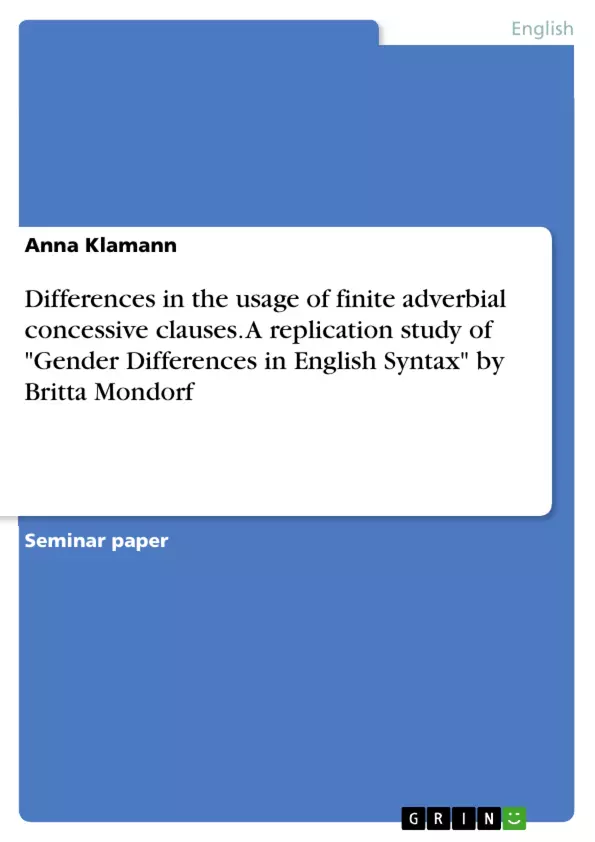This paper is a partial replication of Mondorf’s (2004) study on Gender Differences in English Syntax and combines quantitative corpus data and methodology with the framework of functional grammar to analyse gender-differences in finite adverbial concessive clauses headed by although and whereas. The internal factors of semantic-type and position were examined and the result suggests a strong influence of sex onto the usage of finite adverbial concessive clauses, with an overall result of concessive clauses being the marked domain of men.
Correlations between sex and language are often taken for granted, but empirical studies on this topic, especially in the area of syntax, are surprisingly rare. One of the main studies of the past two decades, about the correlation between sex and language, which investigates sex-differences in specific syntactic constructions, is Britta Mondorf's work Gender Differences in English Syntax. Using the London-Lund Corpus (LLC), Mondorf empirically explores "two areas of marked gender difference in English syntax", namely tag questions and finite adverbial clauses. For the purpose of this replication study, only finite adverbial concessive clauses will be considered. Mondorf’s study demonstrates "the existence of gender differentiated syntactic behaviour in the LLC of spoken British English" and shows that women are “prolific users of those syntactic constructions that signal a low degree of commitment towards the proposition expressed”.
Inhaltsverzeichnis (Table of Contents)
- Introduction
- Theoretical Preliminaries
- Definition and Semantic Function of Adverbial Concessive Clauses
- Interpersonal Meaning and Epistemic Meaning
- Hedges and Boosters
- The Positioning of Adverbial Concessive Clauses
- Lone Adverbial Clauses
- Methodology
- The Data
- The BNC
- Classification Procedure
- Chi-Square and Significance Levels
- Results
- Frequency of Concessive Clauses According to Sex
- Position of Concessive Clauses According to Sex
- Semantic Position of Lone Adverbial Clauses
- Discussion
Zielsetzung und Themenschwerpunkte (Objectives and Key Themes)
This paper aims to replicate Mondorf's (2004) study on gender differences in English syntax, focusing on finite adverbial concessive clauses. The study utilizes quantitative corpus data and functional grammar to analyze gender-based differences in the use of these clauses. The paper examines the internal factors of semantic type and position, aiming to determine the influence of sex on the usage of concessive clauses.
- Gender Differences in English Syntax
- Finite Adverbial Concessive Clauses
- Semantic Type of Concessive Clauses
- Position of Concessive Clauses
- Influence of Sex on Language Use
Zusammenfassung der Kapitel (Chapter Summaries)
The introduction sets the context for the study by discussing the existing research on gender differences in language, particularly in the area of syntax. It introduces Mondorf's (2004) work on gender differences in English syntax and highlights the significance of concessive clauses for this study. The paper outlines its objectives and research questions, focusing on the frequency and positioning of concessive clauses in relation to gender.
The chapter on theoretical preliminaries delves into the definition and semantic function of adverbial concessive clauses, exploring their relationship to interpersonal and epistemic meaning. It discusses the concepts of hedges and boosters, examining how they relate to the positioning of concessive clauses and the speaker's commitment to the proposition expressed.
The methodology chapter outlines the data sources and methods employed in the study. It details the use of the British National Corpus (BNC) as the primary data source and explains the classification procedure and statistical analysis used to examine the data.
The results chapter presents the findings of the study, focusing on the frequency and positioning of concessive clauses according to gender. It analyzes the data to determine the influence of sex on the usage of concessive clauses, comparing the results to those found in Mondorf's (2004) study.
The discussion chapter interprets the findings of the study, drawing conclusions about the relationship between gender and the use of concessive clauses. It contextualizes the findings within the broader literature on gender differences in language and discusses the implications of the results for understanding language variation and social interaction.
Schlüsselwörter (Keywords)
This study focuses on the interplay between gender and syntax, specifically examining finite adverbial concessive clauses. The research utilizes quantitative corpus data and functional grammar to analyze the semantic type and position of these clauses. Key concepts include gender differences in language, concessive clauses, semantic function, interpersonal meaning, epistemic meaning, hedges, boosters, and the British National Corpus (BNC).
- Citar trabajo
- Anna Klamann (Autor), 2015, Differences in the usage of finite adverbial concessive clauses. A replication study of "Gender Differences in English Syntax" by Britta Mondorf, Múnich, GRIN Verlag, https://www.grin.com/document/305082



